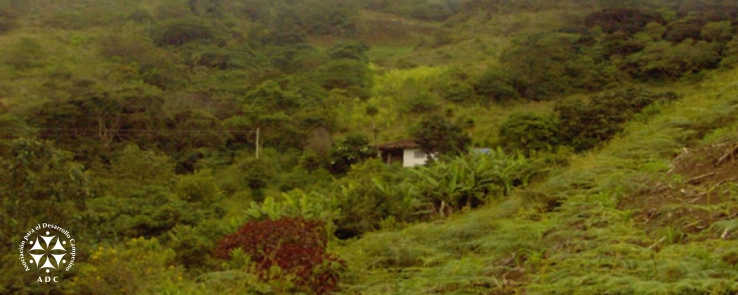
We have a headquarters, the Finca Reserva Comunitaria “Charmolán”, with an approximate area of 18 hectares. It is located in the village of Portachuelo, bordering the municipalities of Chachagüí and Buesaco, where different activities are carried out according to a plan, taking into account their characterization and the areas of conservation, production and available infrastructure with emphasis on training.
In our Minga stand out as productive projects:
- The recovery of hillside soils through level curves, crops through the slope and infiltration ditches.
- The system of sustainable raising of pigs.
- The productive decontamination system of the water used in swine production.
- Production of natural ointments.
- The farm consists of the house, headquarters distributed in a kitchen, dining room, meeting room, accommodation with capacity for 20 people, office and health unit.
Network of Soil Recuperators
Historically, the peasant is identified by his relationship with the land and with agricultural production. Many of the political struggles of the second half of the last century had their origin in movements of land recovery and agrarian reforms that benefited landowners and large farmers in the country. At the beginning of this millennium it is clear that the object of the struggle is not only its possession, but the recovery of the soil as a shelter for seeds, a commitment in which the peasants whose soils are deteriorated, without nutrients and natural fertility, are involved.
Starting from ourselves, from what we have, we do and we are, we identify our resources and we empower them. In this way we decided to transform the soil for our own good and that of others. After several itinerant training events in different parts of the country, 70 people generated an innovative technology that gathered different pre-Hispanic and modern elements, which we applied without resorting to suggestions from exogenous people and we came together to create the Soil Recovery Network.
In this way, we noticeably reduce the loss of soil by the action of wind, water and sun or as a consequence of cultural work; we manage to retain humidity and regulate the presence in different parts of the cultivable fragments; we also contribute to the conservation of biodiversity and family nutrition. The geographical location of the Network allows converting this area into a buffer corridor for the vertiginous advance of the desert of the Patía River basin.
The philosophy of ADC raises the search for happiness with our particular way of being based on what we do, what we have, where we are. Regulated by these principles, we decided to move towards the recovery of our soils by applying different technologies that are adapted to the conditions of the localities where the process takes place.
The fact of living in hillside areas, with over-exploited soils, with prolonged summers, with a history of sharecropping, suggests technologies that are inexpensive, easy to manage by the family and that can be adapted to cultural practices of the community.
For the recovery of soils, we have implemented various technologies, which in a combined way have allowed us to recover and preserve deteriorated soils, among the applied technologies we have ditches on curves at a level, planting in the upper part of the trench plants that help in soil and moisture retention, in the planting of multipurpose trees and shrubs (shade, humidity, production of organic matter, fruit, fodder, etc.), composting production, use of the worm (Eisenia fetida) for the conversion in humus. On these crop residues at certain times, we plant vegetables that are harvested before the use of fertilizer at the time of planting. The fertilizer we use in the crops that are made between the ditches.
Through the history of the process have happened several events that have allowed to have it alive. The main actions are carried out in each of the properties, in each one of the people, in each of the experiences. It can remain passive for some moments and is activated quickly in others. We can not say that the process has had a constant rhythm, this depends on the emotional state of the people, the willingness of the community to participate in it, the degree of commitment of the farmers, the coordination of the advisors, the climatic factors, the local and national context and, above all, the degree of understanding between advisors and farmers.
This process has been built along the way, but it has been clear about its direction and its destiny, to seek the well-being of the associated families and to accompany them in the search for their own happiness. In this way we have not only gone astray, we have misinterpreted ourselves and we have made mistakes that have left the protagonists of their objectives.
Keeping clear the vision of the process, the dialogue of knowledge and the conversation have allowed us to reconcile and reencounter ourselves with our objective. Thus we have advanced, sometimes slow, but with the certainty of arriving at the proposed ports. In each port there is a critical reflection and a rethinking of our dreams, in this way we can navigate in the midst of adversity and continue our journey in search of happiness.